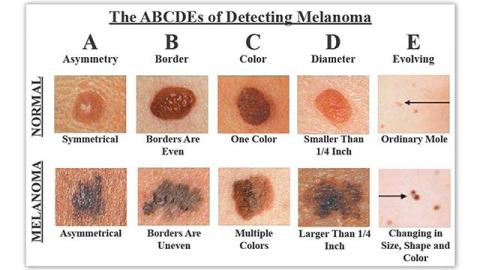
Melanoma Monday: These 5 Little Facts Could Save Your Life
Today is Melanoma Monday, the day set aside to raise awareness about deadly skin cancer.
About 10,000 Americans die from melanoma every year, according to the American Cancer Society, making it the second leading cause of cancer deaths among men and the third among women.
Melanoma diagnoses are up 200% since 1973, perhaps because of increased tanning bed use, which vastly increases your risk. Another big risk factor: childhood sunburns.
However, dermatologists say no one needs to die from melanoma. The key, as in most cancers, is early detection.
Although doctors recommend yearly skin checks in the dermatologist's office, most melanomas are found at home by the patient. If you can spot a melanoma on yourself or someone else, and can get it removed early enough, there won't be a long-term problem.
That's why it's so important we all know how to recognize suspicious moles. It's pretty easy to remember....simple as A,B,C,D,E.
The ABCs of Skin Cancer
A=ASYMMETRY: If you draw a line through the middle of the mole, the two sides won't match in melanoma, but will match in normal moles.
B=BORDER: The edges of a melanoma tend to be uneven, crusty or notched. Normal moles have even borders.
C=COLOR: Melanoma is a variety of colors (white or blue is especially bad) while normal moles are uniform in color.
D=DIAMETER: Melanoma is usually larger than a PENCIL ERASER, normal moles are smaller.
E=EVOLVING: When a mole CHANGES it could be melanoma. This includes changes in size, shape and color as well as itching, bleeding or scabbing.
If you see a mole that fits just one of the above criteria, get it checked by a dermatologist immediately.
Moles can often hide in places we don't often see, such as on the scalp, between toes or anywhere else. So look thoroughly. This may require your asking your hair stylist to look on your head when you're getting a haircut.
The best way to prevent skin cancer is to avoid tanning booths, don't smoke and stay out of the sun as much as possible. When you are outside, wear a hat and protective clothing, sit under an umbrella, etc. Wear sunscreen, reapplying often and try to avoid being outside in the midday sun.



